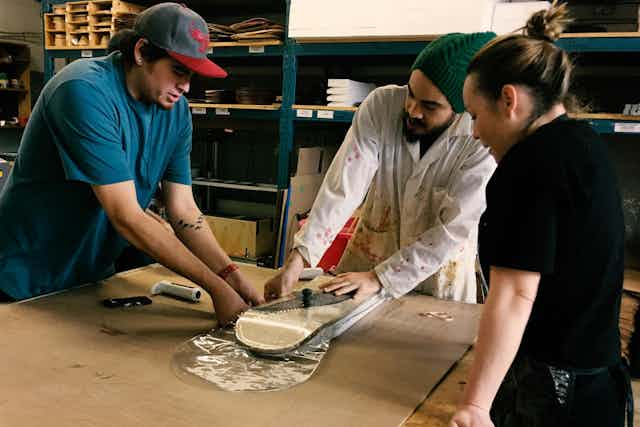A sadly common refrain about young people today is that they are coddled, entitled, self-absorbed and tech-addicted.
But as events this year have shown us, teenagers and young adults are fiercely engaged, strong, resilient and determined to make a mark in the world.
This is something I know firsthand as a longtime and retiring professor of furniture design and construction at the Ontario College of Art and Design University, and the owner of a unique skateboard company that specializes in build-it-yourself kits that have particular appeal to teens and young adults.
Most of my students are fully engaged with the modern world of tech. They have embraced their tech obsession by learning how to use CNC routers, laser cutters and 3D printers when they build furniture.
Read more: Explainer: what is 3D printing and what's it for?
Unfortunately, their interactions with these tools involve handing a program file to a service desk and returning hours later to pick up the milled, cut or layered object.
Bucking tech
I have noticed, however, an increasingly larger group of upper-year students creating objects in wood, metal and plastic shops where they are bucking the hi-tech obsession and using more traditional building methods.
They’re using tools like rulers, saws and chisels rather than the hands-off methods promoted at art institutions to finely craft objects.
Many of them, after having been exposed to the high-tech side of what a well-equipped institution has to offer, change direction to embrace a more hands-on, traditional way of making and ultimately learning.
These students, after graduating, end up being builders of things — and not very interested in creating objects without having some physical input into its creation.
After all the design philosophy and all the classes that teach design theories, this group ends up doing what attracted them in the first place to an art and design university — the making of things.
Unfortunately, too few art and design schools, OCAD University included, celebrate and promote those who build and create using more traditional techniques, even though they use these objects as promotional tools to attract future students — and to justify the institution’s existence.
Art and design schools push students to be concept-driven designers, and do not advocate the craft of making. Recognition goes to the theorists, not those who build and create things with their hands. Students, consequently, feel they have to go that route; to become theorists, not creators.
What’s more, there’s little obvious interest from upper management in the areas where hands-on teaching is done. If there are cutbacks, they are in the areas where hands-on teaching takes place. Technicians and class assistants are often the first to go or fall prey to shortened hours.
Less expertise
Tenure-track highly skilled faculty in these areas are being replaced with contract faculty who have less expertise and little interest in taking extra time to properly give students the valuable lessons needed to be successful creators of objects or works of art.
It’s wonderful when design students find jobs where they can use the concepts taught in a theory-driven institution, but these jobs are few and far between when compared to the masses of students graduating each year.
As a longtime inventor and designer of things, my frustration with the growing trend in design education is what prompted me to create my company, Roarockit.
It’s not about theories and concepts. It’s real-life stuff.
We tell our customers, most of them young and with a passion for creating and designing that cannot be satisfied at today’s art and design schools: “Here are the tools and knowledge to make something. Your job is to design, build and promote it. And if you have a decent product, someone will pay you for it.”
We have taught many classes of at-risk kids how to use our skateboard kits, and seeing the process is a eureka moment for them. They are thrilled by what they can create.
Indeed, Roarockit kits introduce hands-on experience. It causes young people who thought they were useless to say: “I can build this and I am proud of myself. I have made something, I have marketed it, I have sold it and I have made money from it.”
Some of them even donate their profits to charity.
As the Fourth Industrial Revolution approaches, it’s a mistake to assume there will be no need for people who create, who build, who have manual skills. There will always be an appetite for craftsmanship, for art and for the work only human hands can truly bring to life.
Art and design schools would be wise to remember that.

